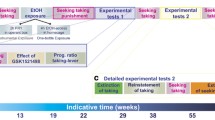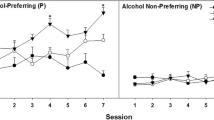Abstract
We have established a rat model that reflects the course of development of alcohol and opiate addiction. The present study with d-amphetamine aimed to define general principles in the development of an addiction. Male rats had a continuous free choice between d-amphetamine solutions (100, 200 and 400 mg/l) and water for 47 weeks. An initial intake of high doses of d-amphetamine during the first weeks of drug choice was followed by an individually stable pattern of drug consumption of moderate drug doses. During this period of controlled consumption (from week 10 to week 40), the voluntary intake of d-amphetamine depended on individual factors (dominant rats: 0.37 ± 0.02 mg/kg per day, subordinate rats: 0.57 ± 0.05 mg/kg per day) and environmental variables (group housing: 0.21 ± 0.02 mg/kg per day, single housing: 0.41 ± 0.03 mg/kg per day). Beginning with week 41, voluntary d-amphetamine consumption progressively increased (1.9 ± 0.2 mg/kg per day in week 47), although the experimental conditions remained unchanged. Drug intake during a retest (free choice as before) after 6 months of drug deprivation revealed that the rats had persistently lost their control over drug intake and were no longer able to adjust drug taking to internal and external conditions. These addicted rats took very high drug doses, even when all d-amphetamine solutions but not water were adulterated with bitter tasting quinine (6.6 ± 0.6 mg/kg per day; age-matched controls: 0.37 ± 0.04 mg/kg per day). Forced intake of d-amphetamine for 47 weeks (7.1 ± 0.3 mg/kg per day) via the drinking fluid caused physical dependence (hyperreactivity during withdrawal) but did not lead to drug addiction (voluntary intake in the retest with adulteration: 0.42 ± 0.04 mg/kg per day). Both the temporal development and the prerequisites of psychostimulant addiction were in principle the same as for alcohol and opiates.
Similar content being viewed by others
Author information
Authors and Affiliations
Additional information
Received: 3 April 1998/Final version: 26 August 1998
Rights and permissions
About this article
Cite this article
Heyne, A., Wolffgramm, J. The development of addiction to d-amphetamine in an animal model: same principles as for alcohol and opiate. Psychopharmacology 140, 510–518 (1998). https://doi.org/10.1007/s002130050796
Issue Date:
DOI: https://doi.org/10.1007/s002130050796




